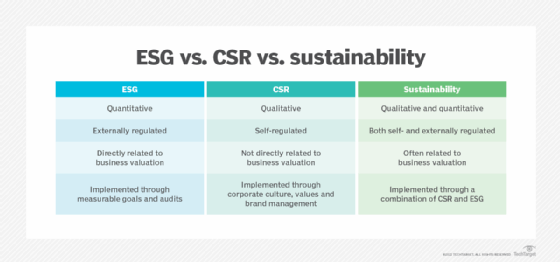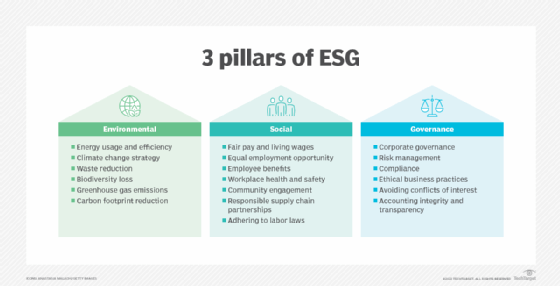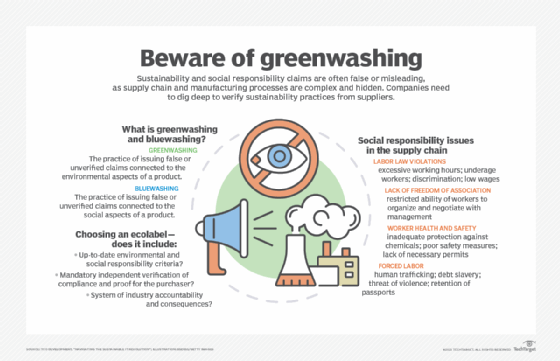Sustainability and ESG glossary: 52 terms to know
Sustainable strategies require a basic understanding of the fundamentals. Business and IT leaders can benefit from this list of essential sustainability terms and ESG concepts.
A-C D-F G-I J-L M-O P-R S-U V-X Y-Z
Ensuring the health of people, the planet and even businesses rests on more sustainable practices, which depend on understanding core concepts and terms.
Many individuals, businesses, nonprofits and government entities are working hard to quickly create and execute specific sustainability strategies and environmental, social and governance (ESG) initiatives. Everyone has a role to play. Learning about sustainability and ESG concepts ensures that critical stakeholders have productive conversations that avoid term misuse and oversimplification.
Climate disruption is having and will continue to have a negative impact on life across the globe. It's imperative that business leaders, private citizens and governments take immediate and decisive action.
Here are some fundamental sustainability terms and ESG concepts that provide a foundation for taking action.
The 50-plus sustainability and ESG terms you should know
- business sustainability. Also known as corporate sustainability, business sustainability is the ethical and responsible management of an organization's continued success with environmental, social and financial concerns.
- carbon credit. When companies create carbon offsetting initiatives, they receive a transferable or tradeable carbon credit, or token. The credit represents the right to emit greenhouse gases and offset them elsewhere. One credit represents one ton of carbon dioxide reduced or removed from the atmosphere. In practice, taking advantage of these credits lets owners reduce greenhouse gas emissions to get closer to net zero. The term also refers to purchased credits that will fund emission-reducing projects.
- carbon footprint. A carbon footprint measures the amount of carbon dioxide and methane produced by individuals, organizations, products or practices.
- carbon neutral. The ideal balance between carbon dioxide emissions produced by human activity and carbon absorption by the atmosphere; the calculation should come to zero.
- carbon offset. A carbon offset is an activity or purchase intended to compensate for carbon emissions produced by individuals and organizations. Carbon storage through tree planting or land restoration is a common example. Businesses with carbon offset programs receive carbon tokens.
- carbon token. A digital asset governed by a smart contract on blockchain that represents a real-world reduction in one metric ton of carbon dioxide emissions. The asset exists to verify ownership and simplify the carbon credit trading process. Another example is a non-fungible token, or NFT, representing a single, unique share of captured carbon dioxide associated with a specific time and place. The dependence on blockchain technology to administer carbon tokens is controversial due to blockchain's energy-intensive processes.
- circular economy. The circular economy keeps products in circulation to the fullest extent possible by reducing material consumption, streamlining processes and collecting waste for reuse.
- clean tech. Sometimes referred to as green technologies or eco-technologies, this term refers to technologies and processes designed to limit negative environmental impacts, such as waste and carbon emissions, especially compared to fossil fuels. Examples of clean technologies include solar power, wind power, biofuels, recycling and smart lighting.
- climate adaptation. The act of preparing for and adjusting to climate change's current and projected consequences. For example, cities can build seawalls to protect from rising sea levels.
- climate change. The shifts over time in the average temperature and weather patterns that define specific locations. In particular, climate change has come to mean the rise in global temperatures from heat-trapping gases resulting from mining and using oil, coal and other fossil fuels. Climate change indicators include rising sea levels; an increase in the severity of extreme weather, such as hurricanes, droughts and floods; and ice loss at the Earth's poles.
- climate mitigation. The process of decreasing the flow of heat-trapping pollution. For example, reducing fossil fuel burning by using renewable energy sources may help.
- climate resilience. The ability to support a community, company or the natural environment before, during and after a climate event in a timely, efficient manner. Climate resilience differs from climate adaptation, although the two terms are often used interchangeably.
- climate risk. As wildfires, droughts, food scarcity, hurricanes and other climate change effects happen, businesses become more vulnerable. Climate risk describes that vulnerability. It is the potential for climate change to create negative effects on human or ecological systems. Risks fall into two main categories: risks based on the transition to a greener economy, such as losing market share by moving away from fossil fuel-based products, and risks related to the physical effects of climate change, such as flooded offices.
- closed-loop. A production process that reuses material waste to create additional products or repurposes recycled materials.
- conscious capitalism. Conscious capitalism is a socially responsible framework for capitalism in the corporate and political spheres. It emphasizes creating human value alongside profit value.
- corporate social responsibility (CSR). For-profit companies use the CSR business model to gauge social and environmental benefits alongside organizational goals, such as profitability.

- digital carbon footprint. The digital carbon footprint is the amount of greenhouse gas emissions digital devices, tools and platforms produce. All tech, from cloud computing to mobile phones to internet usage, produces a digital carbon footprint.
- digital sobriety. Digital sobriety aims to limit the harmful environmental impact of smartphones, internet usage, digital media and other tech in both large and small ways on a daily basis. Moving toward digital sobriety includes a wide range of actions: buying fewer devices, deleting emails, opting for lower-definition media consumption, sustainably developing software and buying less-powerful machines.
- drawdown. A drawdown is the point at which atmospheric greenhouse gas levels stop climbing and start declining.
- electronic waste (e-waste). Electronics at or nearing the end of their useful life. Green tech and sustainability approaches seek to extend the useful life of devices and use circular economy principles to keep the amount of e-waste to an absolute minimum. The priority is to first reduce waste, then refurbish devices, then move toward recycling.
- energy efficiency. The same task or result is achieved with less energy. For example, heating, cooling and operating appliances and electronics are less energy-intensive in energy-efficient homes and buildings.
- environmental justice. Environmental justice seeks to ensure fair treatment of all people regardless of race, color, national origin or income equally, regarding environmental laws, regulations and policies. The approach holds that no group should bear a disproportionate share of negative environmental consequences.
- environmental, social and governance. Sustainable and ethical interests that can be central to an organization's financial and corporate interests. Otherwise known as ESG.

- ESG framework. A set of objectives companies can use in their ESG reporting. A variety of ESG frameworks exist to help companies evaluate their environmental and social impact and assess their internal governance policies, as well as their risks and opportunities.
- ESG reporting. A disclosure that an organization must provide to show how it works to fulfill its ESG promises and efforts. Some organizations are required to report on ESG, depending on the laws and regulations of the country or countries in which they operate.
- feed-in tariff. A policy designed to accelerate investments in renewable energy. A policy of this type usually involves long-term government contracts.
- global warming. Global warming refers to the heating of the Earth's surface from trapped greenhouse gases resulting from human activities, such as transportation, agriculture, overfishing, fossil fuel energy production and overconsumption. Unless companies, governments and consumers make major shifts, global warming and climate change will heat the planet so much that it will be unlivable in the near future.
- green cloud. The green cloud refers to the possible environmental benefits of IT services delivered over the internet. Typically seen as a buzzword, reliance on the alleged benefits can lead technologists to believe that further efforts to reduce carbon footprints are unnecessary.
- green computing. The sustainable approach to using computing devices and equipment is green computing. Some methods include reducing resource use, responsible disposal of e-waste and deploying energy-efficient IT equipment.
- green hushing. Green hushing involves companies intentionally hiding sustainability goals. Companies may do this out of fear of greenwashing accusations or falling short of stated goals.
- green IT. The practice of designing, manufacturing, operating and disposing of IT products and devices to minimize the negative effects of IT operations on the environment is green IT.
- green premium. Coined by Bill Gates, green premium refers to the economic and environmental costs of choosing clean tech over financially sound options with higher greenhouse gas emissions.
- green software. Green software refers to applications that are designed, developed and implemented in ways intended to minimize energy consumption and environmental effects.
- greenhouse effect. The result of carbon dioxide, methane and nitrous oxides in Earth's atmosphere trapping the sun's heat.
- greenhouse gas emissions. The sum of emissions of various heat-trapping gases. Greenhouse gases include carbon dioxide, methane, nitrous oxides and fluorinated gases such as hydrofluorocarbons.
- Greenhouse Gas Protocol. A globally recognized set of reporting and accounting frameworks for managing greenhouse gas emissions from private and public sector operations, value chains and mitigation actions.
- greenwashing. Deceptive, misleading or false claims or actions that an organization, product or service has a positive environmental effect is called greenwashing. Whether intentional or unintentional, the practice is detrimental.

- high emitters. A designation given to companies or countries that emit comparatively high volumes of greenhouse gas. Per capita emissions are used to measure the emissions of nations.
- impact investing. An investing strategy that directs money toward companies that create a measurable, positive change in the world. This may also be called socially responsible investing.
- impact sourcing. A sourcing strategy that directs employment and career development opportunities toward people from economically disadvantaged backgrounds.
- Intergovernmental Panel on Climate Change (IPCC). The United Nations' body for evaluating scientific climate change information. The IPCC releases regular reports on climate impacts and risk, and offers options for mitigation and adaptation.
- loss and damage. Climate-related consequences that people are unable to adapt to, either because the consequence is too severe or the affected community lacks access to the resources to adapt. Loss and damage result from sudden natural disasters, such as floods, or gradual change, such as desertification.
- materiality assessment. A materiality assessment is a formal way of assessing stakeholders' commitment to specific ESG issues and calculating an organization's ESG score. It identifies the effect of a certain issue on a company's performance and competitiveness in the market.
- net zero. The result of lowering greenhouse gas emissions as close to zero as possible and balancing remaining emissions with removals.
- Paris Agreement. The Paris Agreement is a legally binding international treaty on climate change that aims to limit global warming to a 1.5°C temperature increase by the end of the century. The Agreement was adopted at the 2015 UN Climate Change Conference.
- recycling. The process of collecting and processing waste materials, ideally to make new products.
- responsible innovation. Responsible innovation prioritizes ethics and social responsibility in the research, design and production of new technologies or evolutions of existing technology. Responsible innovation posits ethics as a design problem.
- scope 1, 2, 3 emissions. Developed by the Greenhouse Gas Protocol, scopes give organizations a way to categorize their emissions. Organizations may find it easier to control scopes 1 and 2, but scope 3 emissions are the most difficult to track.
-
- scope 1 emissions. The direct emissions generated by an organization's operations. Running machinery, manufacturing products, driving vehicles, heating buildings and providing power to devices generate emissions.
- scope 2 emissions. The indirect emissions generated by an organization's energy purchase and usage. Investment in renewable energy sources may help lower these emissions.
- scope 3 emissions. The indirect emissions generated by an organization's customer and supplier activities.
- supply chain traceability. In sustainability, traceability not only identifies, tracks and traces materials and commodities, but it also verifies sustainability claims across the value chain.
For more on ESG strategy and management, read the following articles:
The social 'S' in ESG: Examples, factors and best practices
A timeline and history of ESG investing, rules and practices
ESG audit checklist: Steps for success
ESG marketing: Why it's important and how to draft a plan
ESG materiality assessments: What businesses need to know
ESG metrics: Tips and examples for measuring ESG performance
- sustainability. The ability to meet present needs without compromising the needs of future generations. In practice, sustainability aligns environmental protection, human well-being and economic development.
- triple bottom line (TBL). According to the TBL accounting framework, the bottom lines calculate financial performance alongside environmental and social effects.
- zero waste. The concept of managing products, packaging and materials responsibly to minimize environmental harm.
Editor's note: This article was updated to reflect changes in terminology around ESG and sustainability topics.
Guilliean Pacheco is a former associate site editor for TechTarget Editorial's CIO, ERP and Sustainability & ESG sites.
Ben Lutkevich is site editor for TechTarget's IT Infrastructure group. Previously, he wrote definitions and features for Whatis.com.
This article is part of







